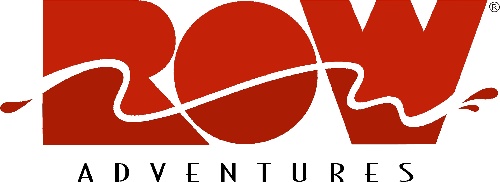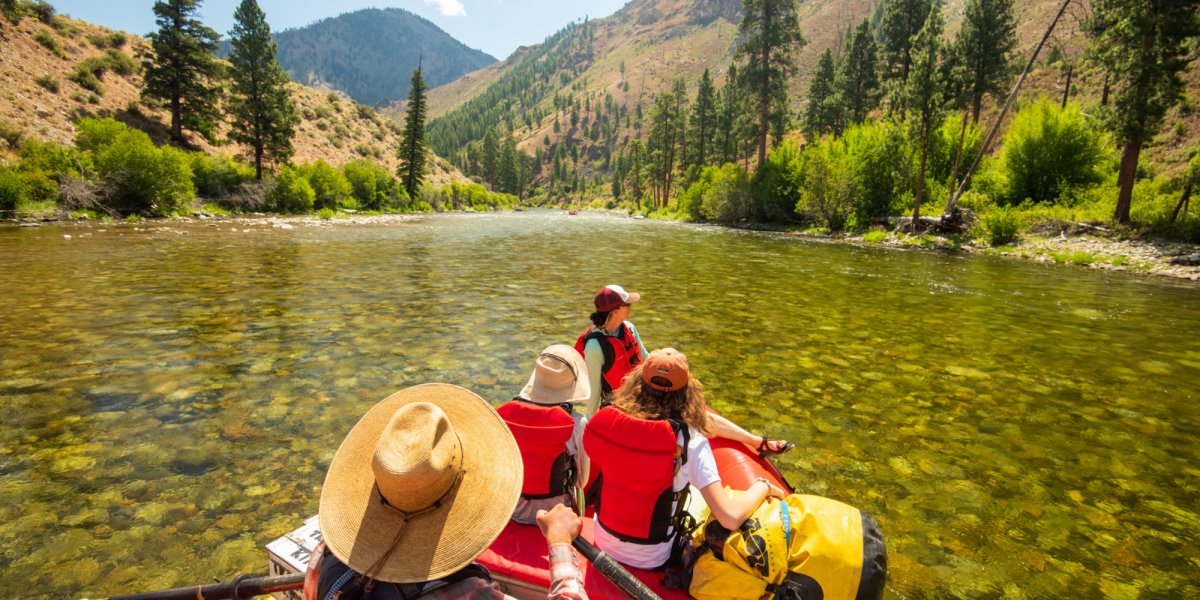Idaho’s Snake versus Salmon River
Idaho has a rich legacy of whitewater rafting and as the state with more free-flowing whitewater river miles than any other, all those drawn to rafting are drawn to Idaho. With some 80 mountain ranges and hundreds of creeks and rivers, Idaho has much to offer the whitewater enthusiast. 69% of the state is public land, and the largest single Wilderness Area in the lower 48 states resides in Idaho. This means the rivers are clean and many, free-flowing.
The two most famous rivers in Idaho are the Snake and the Salmon. As it winds its way through Hells Canyon, the Snake has cut the deepest river canyon in North America. Not to be outdone for superlatives, the Salmon is the longest free-flowing river in the lower 48 states.
The Snake drains 7 states on its way to the Columbia, growing in volume as it flows downhill towards the sea. While thousands raft the Snake near its source by Jackson Hole and Yellowstone National Park, the real show is downstream where the river carves the border between Idaho and Oregon, in Hells Canyon. This is home to the biggest whitewater by volume in the Pacific Northwest.
Outfitters such as ROW Adventures offer trips lasting from 3 to 6 days starting at Hells Canyon Dam and floating north to either Pittsburgh Landing or further to Heller Bar. During high water in the spring, the entire 80-mile stretch can be done on a 4-day trip. As flows decrease in July and August, 5 and 6-day trips allow time for hiking and exploring this rugged landscape.
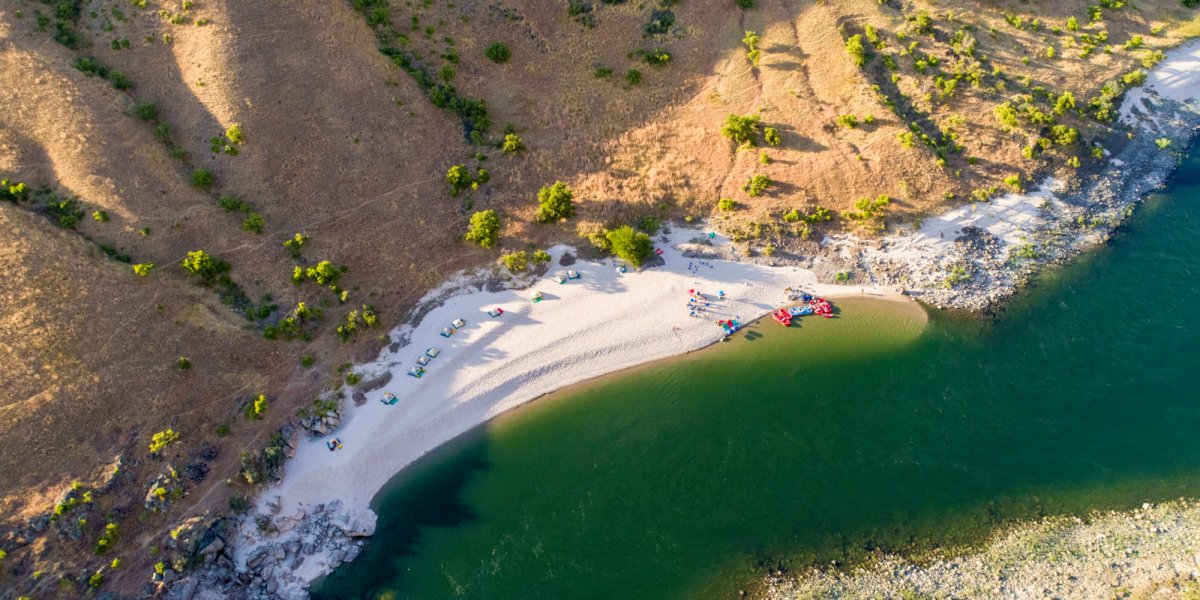
A sandy beach nestled along the shores of the Lower Salmon River Canyons.
Sections of the Salmon River for Rafting and Floating
The Salmon River in Idaho has 4 sections that are commonly floated. The most famous is the Middle Fork of the Salmon, a 100-mile jewel that drops from over 6000’ above sea level to 3000’. Where it ends, the section known as the Main Salmon begins. This 80-mile trip flows west across the state of Idaho, ending about 25 miles upstream of the small town of Riggins. Near Riggins is another stretch of river, about 40 miles in length that we call the “Salmon Near Riggins” for lack of a better name. 20 miles further downstream at the small town of Whitebird we find the beginning of the Lower Salmon River Canyons. Each of these sections is quite different. Below is a description of each and comparisons to provide you a sense of similarities and contrasts.
- Middle Fork of the Salmon: Drops about 28’ per mile, with continual gradient and many technical rapids. The scenery and ecosystem surrounding the river change every couple of days as the river drops from spruce and fir forests in the 6000’ to 4500’ elevation range; then to a wider, bigger canyon with ponderosa pine and finally, the last 25 miles known as Impassable Canyon where sheer granite walls of the Idaho batholith rise dramatically in vertical walls of splendor. Trip length: 75-100 miles. 5-6 days.
- Main Salmon: The gradient diminishes a lot where the Main Salmon starts, with a drop of about 12’ per mile. From the confluence of the Middle Fork and the Main Salmon, the river is what we call “pool and drop” which means there is a calm pool caused by a pile of rocks that create a rapid, like a small dam, and then the rapid or “drop.” During these slower currents between the drops, the river soaks in the sun’s heat and warms up, making for delightful swimming temperatures. The further downstream one goes, the warmer the water gets. This section of the Salmon is quite green, with thick forests of pine and fir. There are lovely white sand beaches for camping. Trip length: 80-90 miles. 5-6 days.
- Salmon Near Riggins: This section of the river has a road along its length, starting 25 miles upstream of the town of Riggins at Vinegar Creek, the ending point of Main Salmon trips. At the town of Riggins, the river turns north and parallels Highway 95 for the next 30 miles. Rafting trips continue 10 miles north of Riggins to take advantage of the best whitewater of this section. This is a popular location for trips lasting from 1-3 days and since there’s a road along the river, it doesn’t have the isolation of the other sections highlighted here.
- Lower Salmon River Canyons: We refer to this as the “Riviera of the West” because of the expansive white sand beaches and warm swimming waters. It’s an idyllic combination and of all the sections of the Salmon River, the best for sun-lovers and children. Almost every camp has the perfect swimming hole with gradually-sloping sand from the bank towards the center of the river. The scenery is exactly what one imagines of the wild west, with steep mountainsides dotted with ponderosa pines and golden grasses. It also has the hottest weather of the various sections since it is at the lowest altitude, and the water is the warmest since it’s had time to gather heat from the sun as it journeys from the mountains some 300 miles upstream. The gradient is about 12’ a mile and this is another “pool and drop” section of the river. Trip Length: 60-71 miles. 4-6 days.

Snake & Salmon River Feature Comparisons:
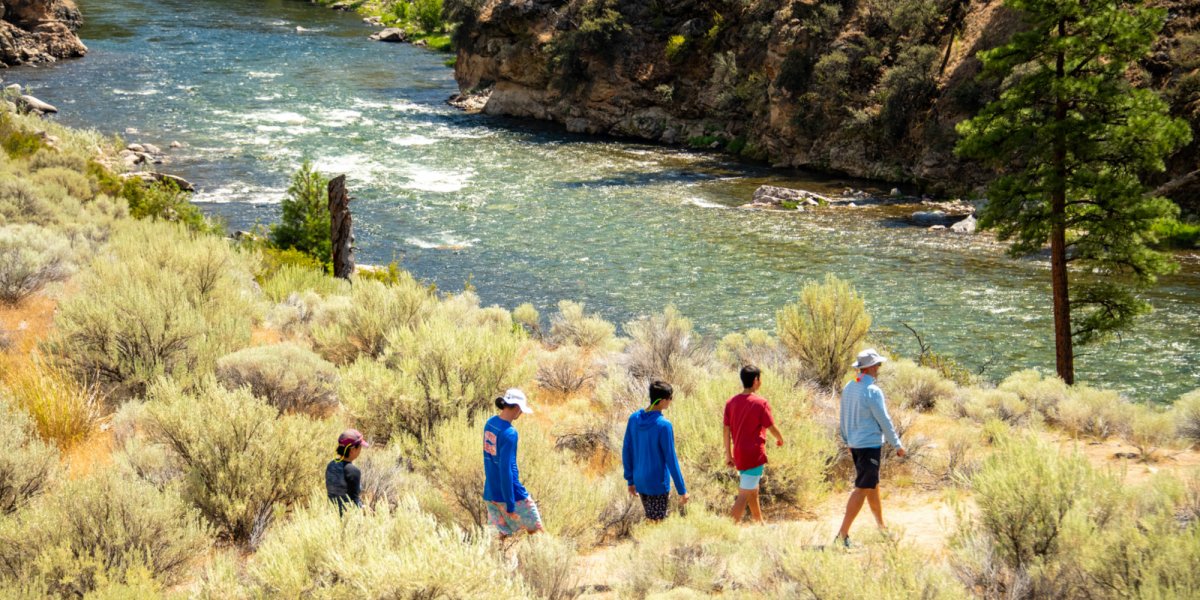
A family enjoys a raft break while hiking a riverside trail along the Middle Fork of the Salmon.
Hiking:
The Middle Fork has the best hiking trails of all the sections followed by the Snake River in Hells Canyon. On the Middle Fork, there is a trail that parallels the river for the first 75 miles as well as trails up many of the tributary creeks. If hiking is high on your list, either the Middle Fork or Snake in Hells Canyon are a good match. The Main Salmon offers some good hiking trails some of which follow tributary creeks that flow into the river, and others along the river's edge. Hotter weather and lack of trails make for few hiking opportunities on the Lower Salmon River Canyons. For hiking enthusiasts, ROW Adventures offers raft-supported hiking trips on both the Middle Fork and Snake Rivers.
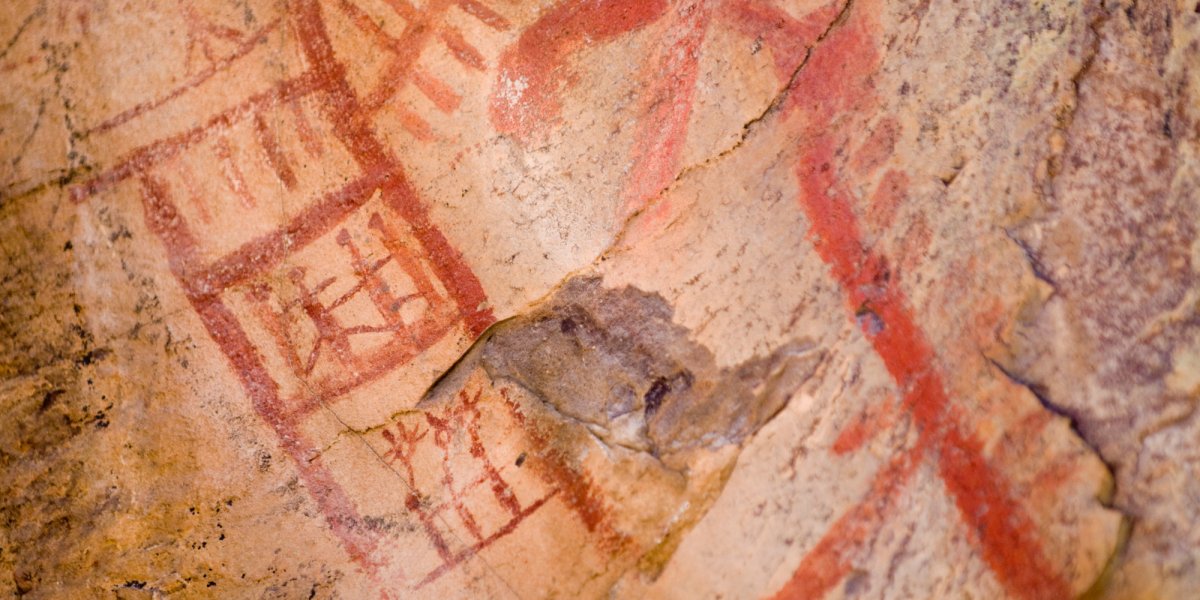
Rock art left by the indigenous people who inhabited the wilderness of Idaho. This particular image was captured along the Lower Salmon River Canyons.
Native American Legacy:
We honor the legacy of the Native Peoples through whose traditional lands these rivers flow. The Snake in Hells Canyon, Middle Fork of the Salmon, Main Salmon, and Lower Salmon River Canyons all have Indigenous People's rock art as well as the remains of their ancient pit houses. The Middle Fork has the greatest abundance of rock art sites, followed by the Snake. Please read our Territory Acknowledgement page to learn more about the Indigenous People of the rivers we run.
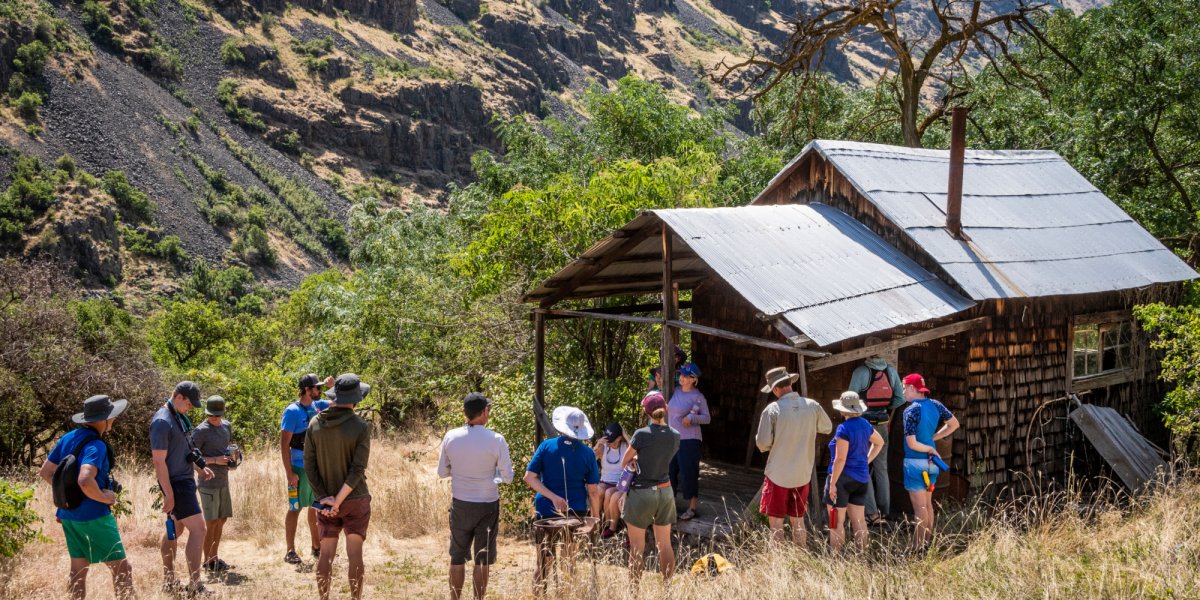
ROW guides lead guests on a tour of a pioneer homestead along the Snake River in Idaho.
Pioneer History:
Each section of the river has plenty of pioneer history, with old homesteads and stories of those who tried to make a living in these canyons. Famous legends on the Middle Fork include those of Earl Parrot and Zane Gray. On the Snake, the stories are countless. Chinese immigrant Polly Bemis is the star of the Main Salmon, as is the homestead at Campbell's Ferry. Equally amazing, the Lower Salmon River Canyons has a unique history of Chinese miners and the best-preserved Chinese rock houses from the late 1800s anywhere outside of China.
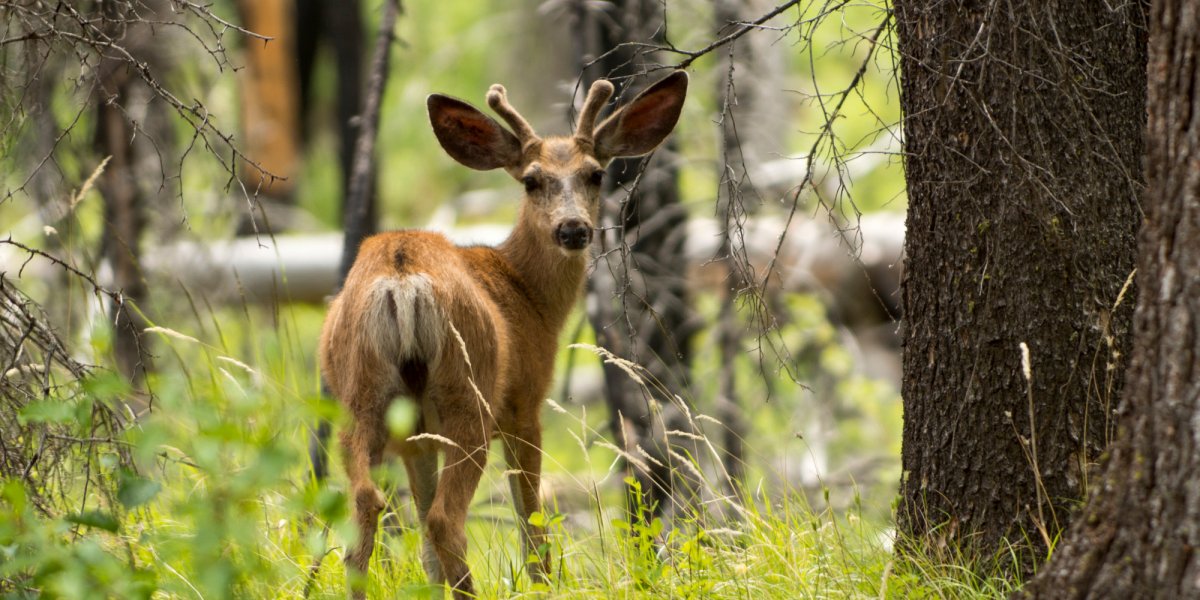
A mule deer peers out at hikers from the wilderness along the Salmon River.
Wildlife:
We usually see some sort of big game on each river. On the Snake, we see mule deer, black bear, and sometimes bighorn sheep and rarely, mountain goats. On the Middle Fork and Main Salmon, you're very likely to see bighorn sheep, and you might see deer, elk, and black bear. River otters, hawks, falcons, eagles, mergansers, and abundant songbirds are common to both rivers. Wildlife viewing is always serendipitous.
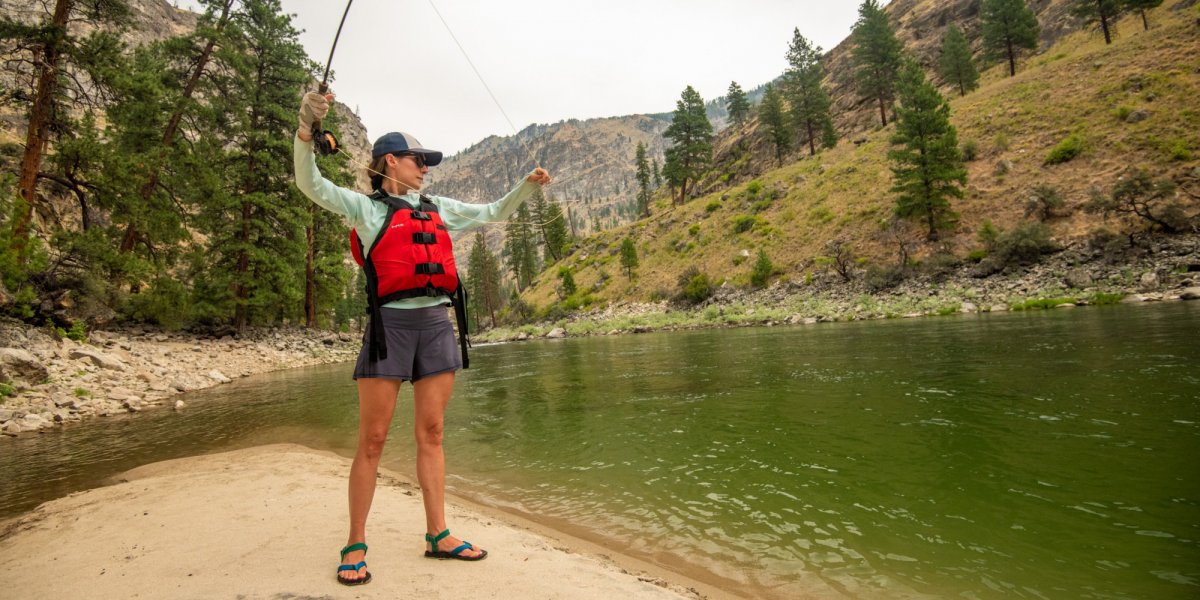
A ROW guest practices her fly cast during some downtime at camp on the Middle Fork of the Salmon River.
Fishing:
The Snake has rainbow trout and smallmouth bass, best caught on lures, although some people do fly fish, and is a catch-and-keep fishery. The Middle Fork is the most productive of these rivers and is an amazing blue-ribbon native cutthroat trout fishery. Only single, barbless hooks are allowed and fishing is strictly catch-and-release. The Main and Lower Salmon River Canyons are somewhat productive with smallmouth bass and rainbow trout. Just remember, the fishing is always great, but the catching sometimes less so. For those interested in fishing, ROW Adventures offers a fly-fishing trip along the Middle Fork Salmon River.
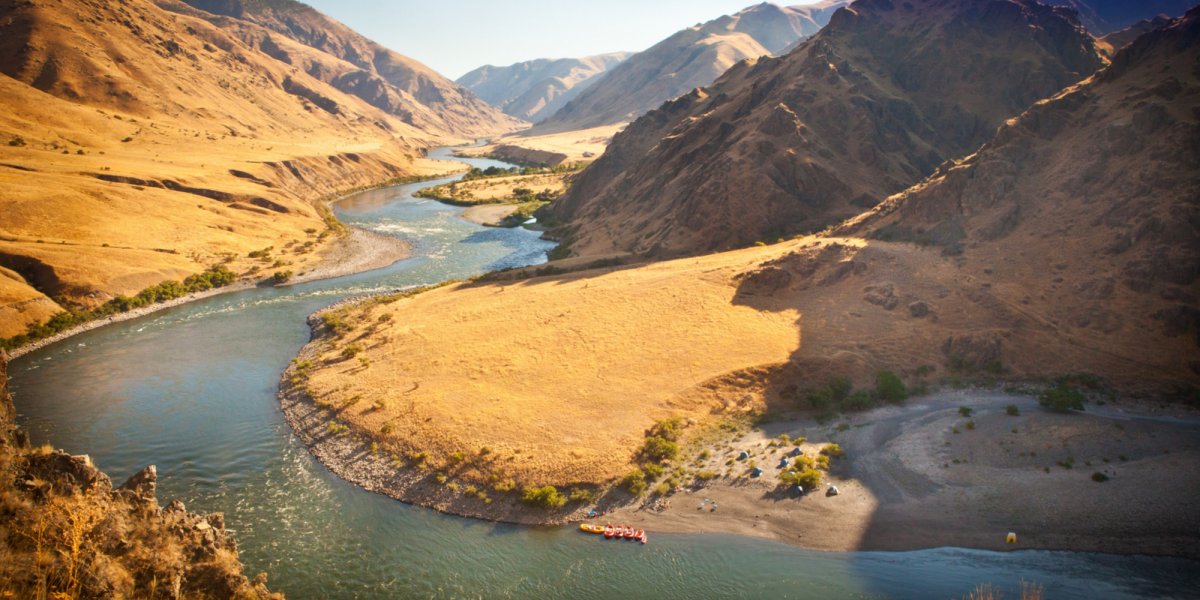
An overlook showcasing the beautiful golden landscape surrounding the Snake River (ROW camp at the bottom beach)!
Scenery:
All these rivers offer spectacular scenery.
- Snake River: The gorge on the Snake rises to over 5000' on each side of the river with impressive rock formations and forests on the north-facing slopes. The scenery changes daily as we travel downstream and at a few points we gaze on peaks that reach 7900'.
- The Middle Fork is a more alpine environment and the first two days we float through a thick forest of fir and spruce. The river drops about 28' per mile, so by the end of the second day, we're at 4000' or so in elevation and in a much more arid, warmer environment with slopes of ponderosa pine and sagebrush. The last two days are spent between the vertical walls of Impassable Canyon.
- The Main Salmon drops about 12’ per mile, so 960’ over the course of the trip. Due to the east-west orientation of the river, the left bank (north-facing) has thicker forests. Huge white sand beaches are an added attraction and every day the canyon scenery changes in subtle ways.
- The Salmon River near Riggins has dramatically steep mountains on both sides, with a slight compromise of quality due to the road that follows this section of river. The mountains are dramatic, with ponderosa pines and black rock outcroppings adding to their beauty.
- The Lower Salmon River Canyons is named for the fact that the river flows through 4 distinct canyons (Green, Cougar, Snowhole and Blue), each with its own geology and landscape. Most of the rapids occur within these named canyons where the river is constricted, and between them the river widens and steep mountainsides rise up to an almost-always resplendent blue sky. The mountain sides are studded with towering ponderosa pines, while net leaf hackberries and mountain mahogany grow just above the rocky shores and expansive beaches.
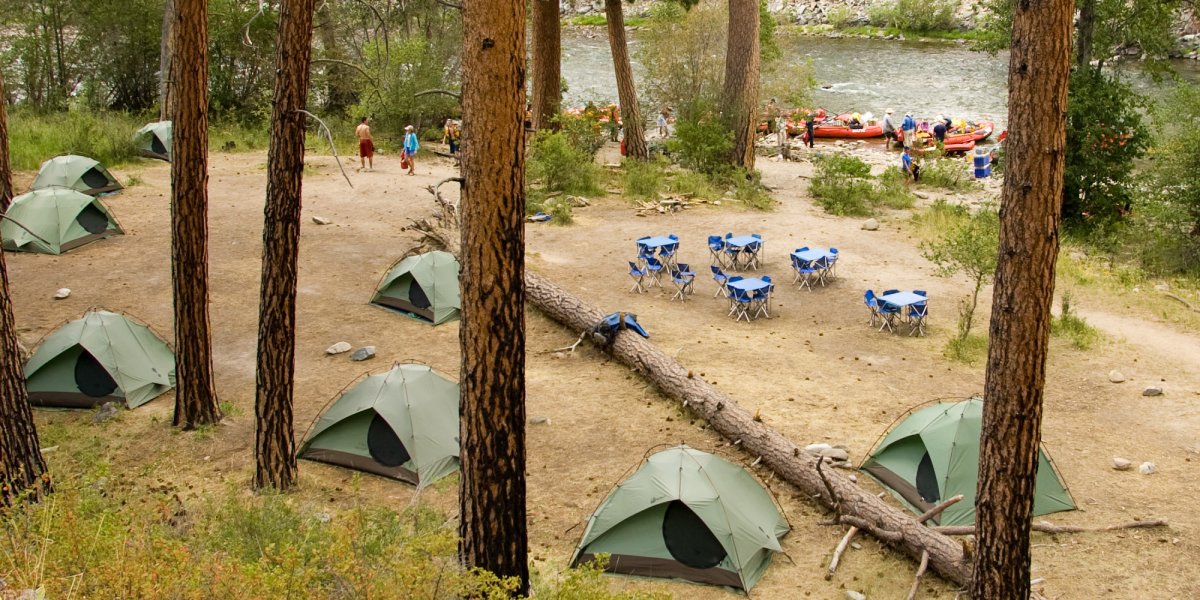
ROW's riverside camp on the Middle Fork of the Salmon River.
Camping:
Camps on the Snake are set on benches of dirt and sand 5-10’ above the river level. Because the Snake is dammed, river levels fluctuate making for a rocky shoreline. The Middle Fork has a mix of beach camps and benches, but most are forested, flat benches set 10-15 vertical feet above the river. The Main Salmon, Salmon Near Riggins and Lower Salmon River Canyons have big sandy beaches for camping. These beach camps are one of the main reasons that the Salmon River Canyons is our location for our Family Magic™ trips designed for families with rafters ages 5 and up. Younger ages are allowed on the Snake and Main Salmon as well. Kids in the 5-10-year-old bracket will generally find a better fit on the Snake, Main Salmon or the Salmon River Canyons than the Middle Fork. To learn more, watch now: Camping with ROW!
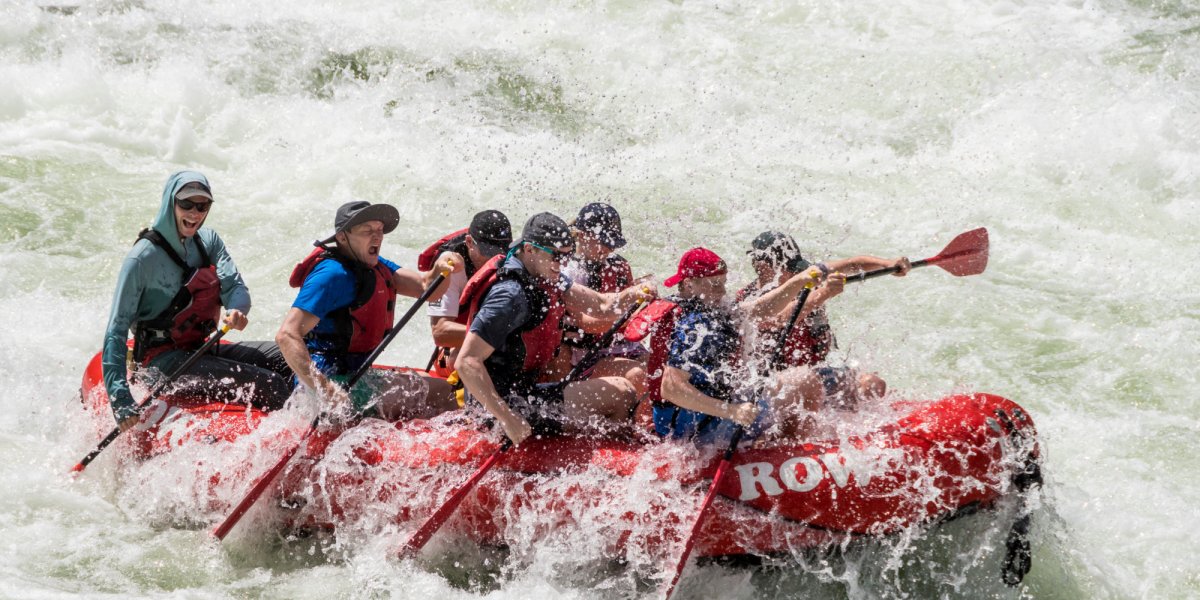
A paddle raft on the Snake River through Hell's Canyon.
Rapids and Flows:
The Snake is a dam-controlled river and is raftable year-round. The biggest flows (25,000 - 60,000 CFS) are generally in May, June, and September. In September no other river in the West has rapids as big as the Snake! On the Snake, Main Salmon, Salmon Near Riggins and Lower Salmon River Canyons, the rapids are what we call "pool and drop" which means that after each rapid, or drop, there is a calm pool where we drift and enjoy the scenery. The waves are generally bigger than on the Middle Fork, but the rapids are less technical (meaning that they require less maneuvering.)
The Middle Fork is the steepest of these rivers with a "continual gradient" and almost constant current. There are still distinct rapids, with rocky, challenging courses, but between the rapids, the river flows quickly and is generally too shallow to jump in for a swim. It is definitely a more exciting trip earlier in the season and on our June launches, we recommend this trip for experienced rafters age 16 and up. Our Middle Fork Flows blog offers a more in-depth look at the natural flows of the Middle Fork of the Salmon.
All the rivers have higher flows in May and June, tapering off as the summer continues and the snow in the high mountains melts and diminishes. For more information about rapids and flows, visit our Whitewater Classifications Blog.
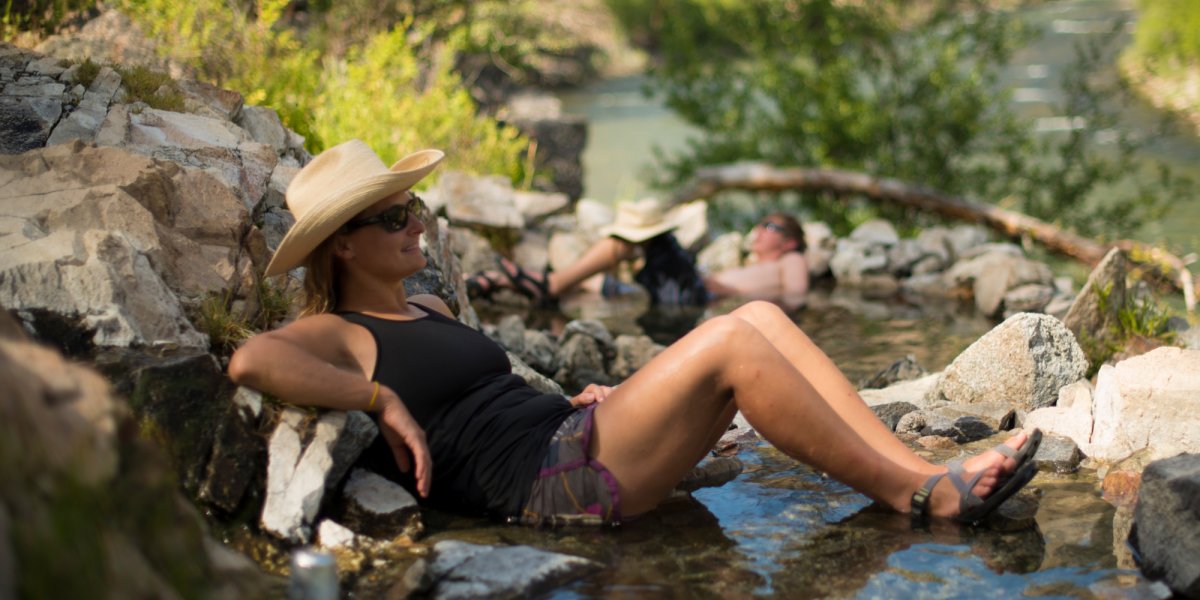
Relaxing in a riverside hot spring along the Middle Fork of the Salmon river in Idaho.
Hot Springs
Natural hot springs are a magical feature of rivers in the northern Rocky Mountains. There are 6-7 along the Middle Fork and we make a point of visiting at least 1-2 on every trip. The Main Salmon has a famous one called Barth Hot springs. On the Salmon Near Riggins, our 2 and 3-day trips have an optional hike to a hidden hot springs high up on a mountainside. The Lower Salmon River Canyons and Snake River in Hells Canyon don't have hot springs as a feature.
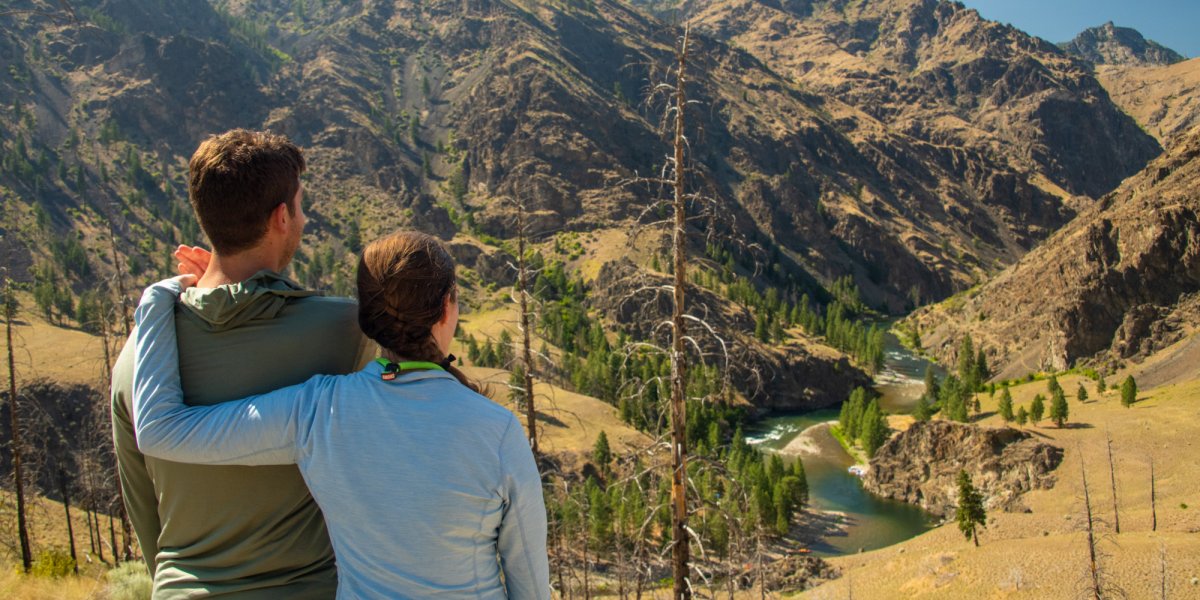
A couple overlooks the Middle Fork of the Salmon River from a vantage point along a riverside hiking trail.
Weather:
Weather on the Snake and Lower Salmon River Canyons is generally hotter due to the fact that they are lower in elevation. Their launch points are around 1600' above sea level. By contrast, the Middle Fork put-in is at 6000' elevation and the Main Salmon around 3000’. Daytime temperatures in June range from 75-80 on the Snake and 65-75 on the Middle Fork or Main Salmon; while in July and August, temperatures of 85-95 are common on all the rivers and on the Snake and Lower Salmon River Canyons can sometimes reach 100 degrees or more. Luckily it’s that wonderful dry heat of the West and the river is there to cool you down.
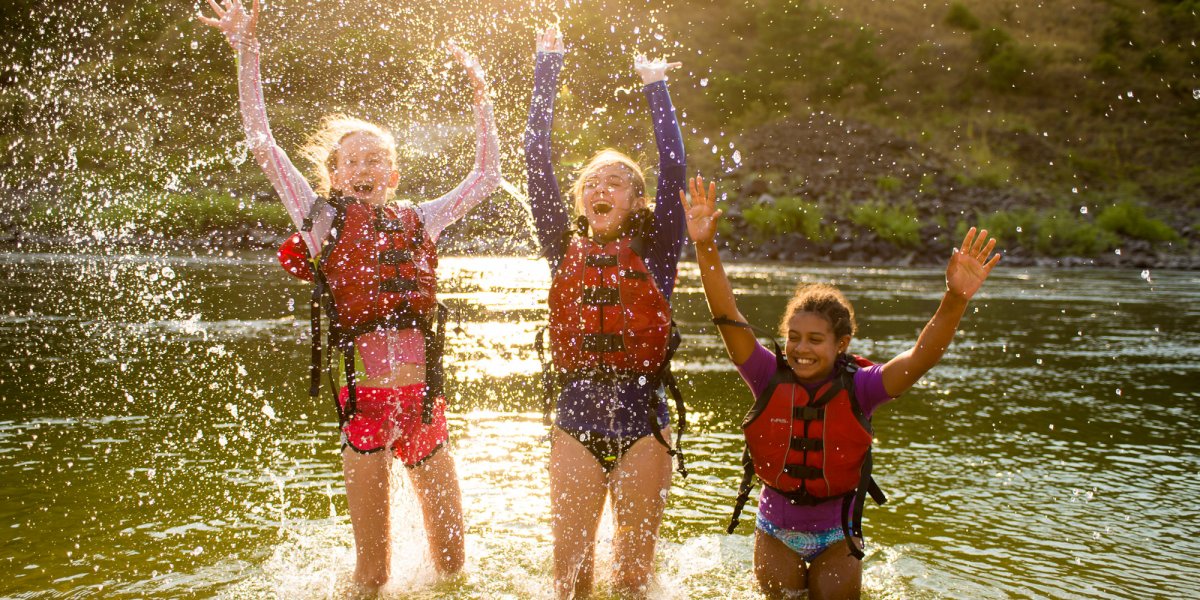
A group of kids plays in the water during our Family Magic Rafting trip on the Lower Salmon river.
Water Temperature:
In the spring when the snow is melting, the rivers are colder. The Middle Fork of the Salmon will be 40-50 degrees in May/June warming to 60-70 later in the summer. The Main Salmon will be warmer, with 45-55 degrees in May/June and 60-65 later in July and August while the Snake and Lower Salmon River Canyons will be 50-60 in May/June and 64-72 later in the summer. By the third or fourth week of August, all the rivers start to cool down again as crispy nights cool the water.
Snake & Salmon River Guest Logistics
Each river has a different meeting and ending point and this may factor into your plans. I would rank the simplicity of the logistics as follows, with the simplest first:
- The Salmon River Canyons is the simplest as you can either fly or drive to Lewiston, Idaho and the trip is run roundtrip from there with no added cost.
- The Salmon Near Riggins requires having a car and driving to the town of Riggins, Idaho where the trip starts and ends. It’s easy enough to fly to either Boise or Lewiston and rent a car at those airports.
- The Snake in Hells Canyon is also fairly simple. You can fly into Boise at the start of the trip and then ROW provides transport to the small town of Cambridge where we meet. The trip ends in Lewiston and you can fly home from there. If you drive, you can drive to Cambridge and then have your car shuttled (for a fee) to the take-out point.
- The Main Salmon trip starts in the town of Salmon, Idaho. Air taxis fly from Boise to Salmon. At the end of the trip, those who flew to Salmon are taken to Lewiston, Idaho where there is commercial air service. Those who drove have a choice of having their car shuttled from Salmon to a point near our take-out, or taking an air taxi from the town of Grangeville back to Salmon.
- Middle Fork Salmon. The date of your trip determines logistics. During higher flows the actual put-in point is a place called Boundary Creek. As water levels drop, the upper 23 miles becomes too low to float and the put-in moves downstream to Indian Creek, accessible only by small airplanes. Because of the changing put-in points, and based on our 32+ years operating on the Middle Fork, our logistics are as follows. Trips departing from May through the July 22 launch, meet in Stanley, Idaho. You can drive to Stanley, or take an air taxi service from Boise. These trips end in the town of Salmon and if you drove, you can have your car shuttled to Salmon for an extra fee. Or take an air taxi back to Boise. From July 30 through September (when more likely than not we will launch at Indian Creek), our trips begin and end in Salmon. If you drive to Salmon, the only additional cost is the air taxi flight to the put-in at Indian Creek. If you fly from your home, fly to Missoula, Montana and then rent a car for the drive to Salmon.
A ROW Adventures Oar Raft floats through a gentle section on the Middle Fork of the Salmon River.
Snake & Salmon River Management:
All these rivers are managed by the Forest Service except for the Salmon Near Riggins and Lower Salmon River Canyons which is managed by the Bureau of Land Management (BLM). Although all are popular, launches are restricted, and the rivers rarely feel crowded. We do encounter jet boats, which are motorboats that travel the river for fishing and sightseeing, on all the rivers except for the Middle Fork Salmon. On the Snake, we may see 3-4 on some days and other days as many as ten. On the Middle Fork, there are no jet boats, but low-flying airplanes are sometimes seen or heard, more so in later July and August as water flows diminish and trips need to start at Indian Creek, about 25 miles downstream of the normal starting point.
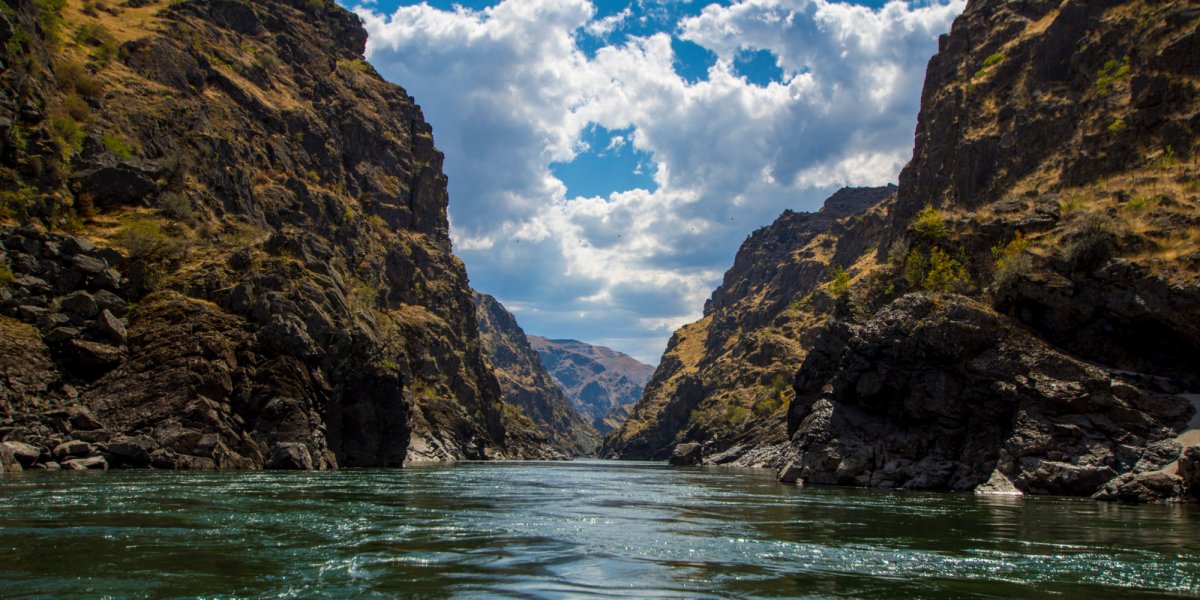
Many rafters are surpised to learn that Hells Canyon is North America's deepest river gorge at 7,993 feet (yes, even deeper than the Grand Canyon)!
Salmon River - The River of No Return:
What is the "River of No Return"? This name came to be sometime in the later 1800s when the general view was that a trip on the Salmon River was a one-way affair, there being no way to return upstream. This name generally refers to the section of the river described here as the Main Salmon, from Corn Creek below the confluence with the Middle Fork of the Salmon, as far downstream as Riggins. However, since it’s the same river all the way to the Snake, one can make the argument that the Lower Salmon River Canyons should be considered part of the River of No Return.
I hope this description helps you decide which of these Idaho rivers would best fit your desires. As a guide for over 40 years, I find them to each have their own intrigues and qualities, beauty, and mystery. Give yourself the gift of time and float them all!

Peter Grubb, Founder
